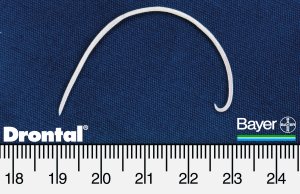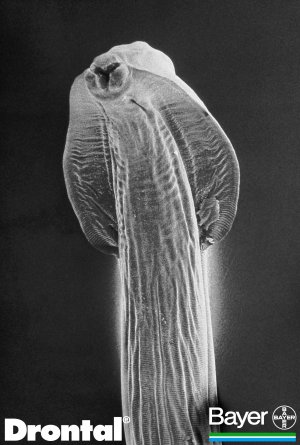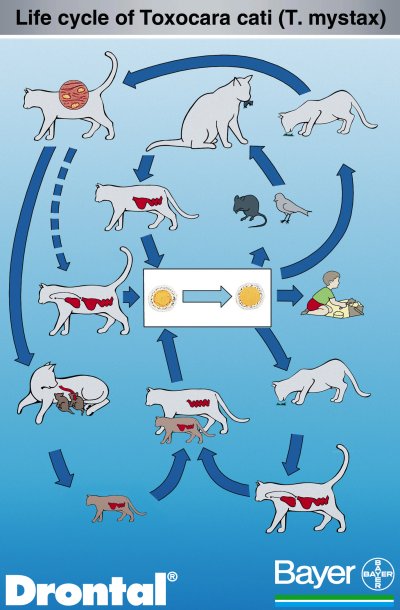
|
TOXOCARA CATI
This information is provided by
Provet for educational purposes only.
You should seek the advice of
your veterinarian if your pet is ill as only he or she can correctly advise
on the diagnosis and recommend the treatment that is most appropriate for
your pet.
Note for Pet Owners: Kittens
are not born with the disease but they are infected after birth
Topics on this Page:
|
Description
Infection with the worm Toxocara cati is called Toxocariasis. Many cats
have the worm present in their body but they may show no external
signs of disease. However, these cats periodically pass the egg stage of the
worm in their faeces and so contaminate the environment and act as a source of
infection for spread to other animals.
Cause


Electron Microscope Image
Breed Occurrence
There are no specific breed predispositions. All cats can be infected by Toxocara
cati. Wild cats can also be infected by this parasite.
Signs
Young kittenss are most likely to show clinical signs, and these will be worse if the kitten has a large number of worms.
Signs include vomiting, diarrhoea, stunted growth rate, distended abdomen (pot-bellied appearance), pale mucus membranes (eg gums). Sometimes infected kittenss have abdominal discomfort, groan when touched or lifted and are reluctant to move.
Death is rare , but has been reported and has been due to obstruction of the intestine or ulceration and perforation of the intestine wall.
Life-Cycle

- Worm eggs are passed in the faeces of cats infected with the worm. These eggs are very small but can be seen by examining samples of the faeces under a microscope.
- After a period of maturation in the environment these eggs become infective to other animals. This period of maturation depends upon weather conditions and environmental temperature in particular. In the UK it takes 2-3 weeks during the summer and several months during the winter. The eggs can survive for 2 years or more in the environment.
- The infective eggs are ingested and can develop in intermediate hosts including earth-worms, cockroaches, birds, rodents and dogs. The infective eggs or larvae are then ingested by a cat.
- The larvae that hatch from the eggs develop into mature worms in the small intestine and start shedding eggs after a few weeks.
Kittens can be infected after birth through milk - but they are not infeted in the uterus.
Diagnosis
All kittens should be assumed to be infected.
Diagnosis can be confirmed by identifying Toxocara cati eggs in faeces samples. However it should be remembered that eggs are not being shed into the faeces all the time, so false negative results are possible.
Treatment
- Fenbendazole (Panacur - Intervet) at a dose rate of 50mg/Kg body weight per day for 3 days OR 100mg/kg body weight as a single dose in pregnant queens
- Mebendazole at a dose rate of 50mg twice daily for 2 days for kittens less than 2 kg body weight, 100 mg/kg body weight twice daily for 2 days if over 2 kg body weight.
- Pipreazine at a dose rate of 80-100 mg/kg body weight
Prognosis
The prognosis is good.
Long term problems